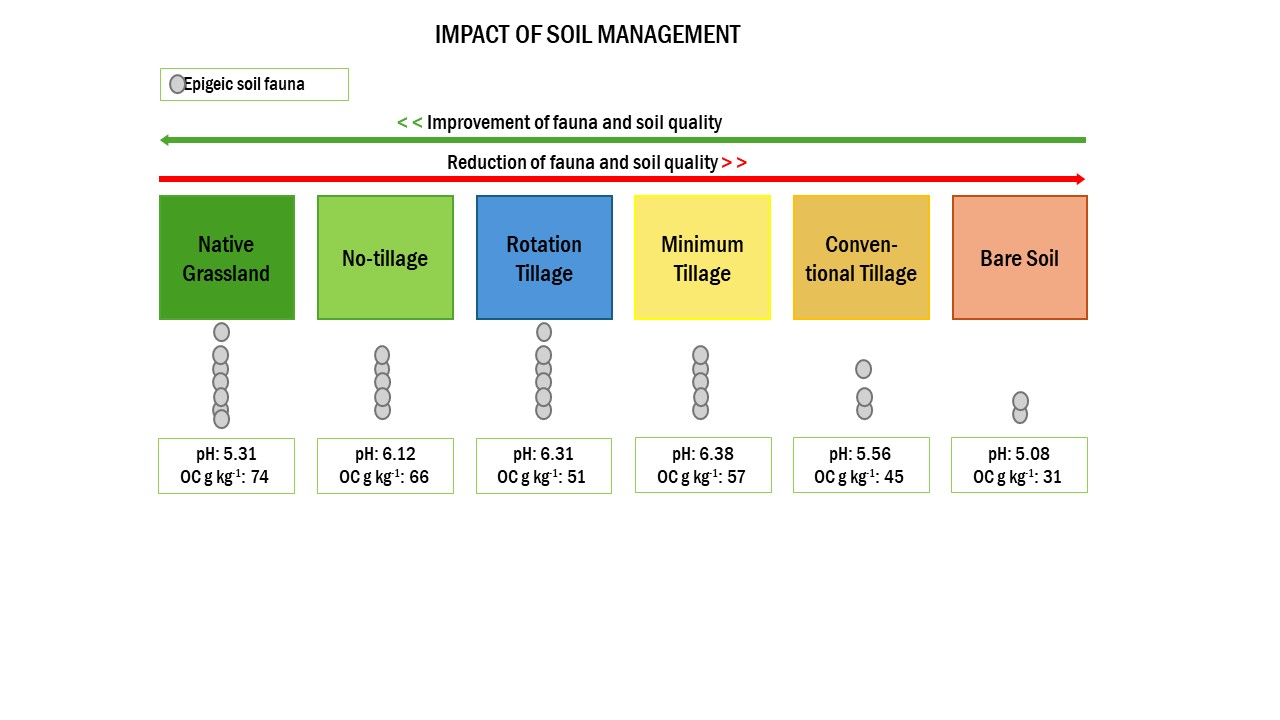Impact of long-term soil management on epigeic soil fauna and soil properties of an Inceptisol with high organic matter
12/Sep/2025
ABSTRACT Agricultural yield depends on a series of ecosystem services provided by soil biota, among other factors. Soil management systems that are more sustainable than conventional tillage mitigate harmful effects to soil, improving the structure and function of the soil biota and facilitating ecosystem services. This study aimed to evaluate the effect of soil management practices on epigeic soil fauna and soil physical, chemical and microbiological properties. The experimental design was completely randomized, with the following treatments: NT – no-tillage; […]
Soil macrofauna correlations with soil chemical and physical properties and crop sequences under no-tillage
18/Jul/2023
ABSTRACT Soil macrofauna is an important indicator of soil quality, as it is sensitive to changes in the environment as a result of soil management, which includes soil chemical and physical properties and the diversity of cultivated species. This study aimed to evaluate the composition and structure of soil macrofauna under a no-tillage system in different crop sequences, with and without crop rotation, over two growing seasons: a rainy summer and a dry winter. The crop sequences were soybean/corn rotation […]
Contribution of Topography and Incident Solar Radiation to Variation of Soil and Plant Litter at an Area with Heterogeneous Terrain
01/May/2015
Natural processes that determine soil and plant litter properties are controlled by multiple factors. However, little attention has been given to distinguishing the effects of environmental factors from the effects of spatial structure of the area on the distribution of soil and litter properties in tropical ecosystems covering heterogeneous topographies. The aim of this study was to assess patterns of soil and litter variation in a tropical area that intercepts different levels of solar radiation throughout the year since its […]
Redox index of soil carbon stability
01/Oct/2010
As an alternative to the relatively complex and expensive spectroscopic methods, the redox properties of humic acids, determined by potentiometric titrations, have been used to evaluate the stability of soil organic C. The objective of the present study was to establish a Redox Index of C Stability (RICS) and to correlate it with some properties of the humic acids extracted from different modal soils in Brazil (distinct weathering stages or management) to facilitate system comparison. The RICS was efficient for […]
Redox properties of humic acids isolated from a soil Under long-term sugarcane cultivation
01/Jun/2008
Soil organic matter is the largest carbon reservoir in natural systems. In such systems the carbon quality and stability can be estimated based on the increase of humified fractions which, among other factors, is related to the balance between losses and accumulations involving oxidation and reduction reactions of the soil organic matter. The objective of this study was to evaluate the electrochemistry of humic acids isolated from soils cultivated continually with sugar-cane, with or without pre-harvest burning and annual vinasse […]
Soil quality under different uses and native Cerrado
01/Oct/2007
Sustainable soil use is becoming increasingly relevant given the increase of anthropic activities. In order to evaluate the soil quality, soil samples were collected from five areas: natural Cerrado (reference), native pasture, planted pasture, annual crops under conventional tillage and pine forest. The areas are located in the Federal District, Brazil, in a clayey Red Yellow Latosol (Acrustox). The following soil quality attributes were measured: bulk density, mechanical resistance to penetration, water infiltration rate, organic matter content, cation exchange capacity, […]
Redox properties and functional groups of humic acids isolated from organic residues
01/Jun/2007
According to the system conditions, humic acids act as oxidants or as reductants. In natural systems the electron flow is directly associated with humus content and quality. Electrode potential and oxidation capacity inform about the intensity and capacity of the redox systems. In previous studies it has been assumed that free radicals participate in humic acid redox reactions. In our study six humic acids isolated from composed organic residues were titrated with an oxidant (I2) in inert atmosphere and specified […]
Spectral variations in soils amended with filter cake
01/Jun/2005
The aim of this study was to evaluate spectral curves of three different soils amended with organic residues derived from the cane sugar industry. It was used disturbed samples of four soils of distinct classes: a typic dystrophic Red Latosol (Haplustox-LVd), a typic dystroferric Latosol (Rhodic Ustox-LVdf), a typic dystrophic Argisoil (Rhodustults-PVd) and a Cambisol (Dystropept-CXa). They were amended with 0, 40 or 80 t ha-1 of organic residues derived from the cane sugar and alcohol industry (filter cake). Spectral reflectance of […]
Calcium and magnesium release by porous ceramic cups used to extract soil solution
01/Aug/2004
The use of porous cups to extract soil solution is interesting because it is a non destructive method. However, there are some uncertainties regarding the possible release of ions from the cups that would contaminate the extracted solution. An experiment was carried out at the College of Agricultural Sciences/UNESP, Botucatu, State of São Paulo (Brazil) to evaluate the Ca and Mg release by ceramic porous cups. Two tests were performed, consisting of four treatments: T1 – washing the cups with […]
Potassium forms in lowland soils and availability to common bean
01/Aug/2004
The present study had as objectives to characterize K forms, plant use of these forms and to evaluate the common bean (Phaseolus vulgaris L.) response to K application in four lowland soils. It was also sought to determine the critical levels for K in soils and plant. The experimental design was completely randomized in a 4 x 5 factorial scheme with four replications. The treatments were a combination of four lowland soils [Mesic Organosoil (OY), Melanic Gleysoil (GM), Haplic Gleysoil (GX), and […]


